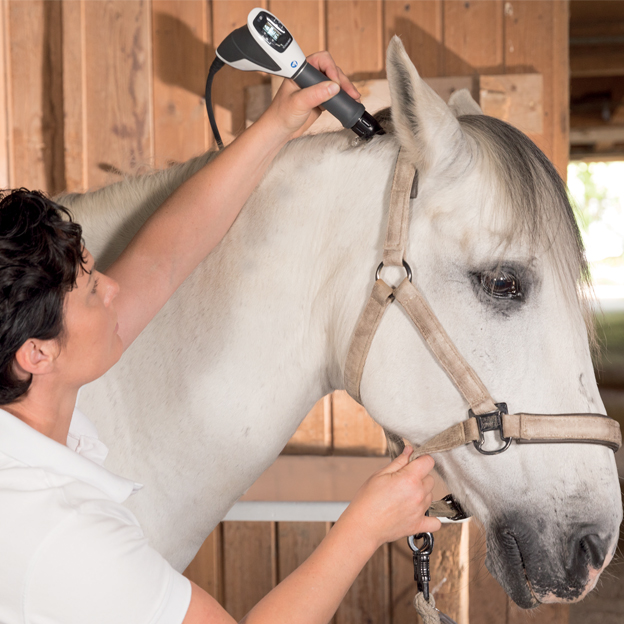Why Equine Therapy is Becoming a Preferred Option for Emotional Health
Why Equine Therapy is Becoming a Preferred Option for Emotional Health
Blog Article
Laser Treatment in Equine Treatment: A Modern Technique to Improving Steed Health
Laser treatment has actually arised as a critical technique in equine treatment, utilizing focused light power to promote cellular repair and quicken recuperation from a range of ailments. By promoting mitochondrial activity and increasing ATP production, laser treatment not only improves flow but also supplies significant pain relief.
Understanding Laser Treatment
Laser therapy, a non-invasive therapy modality, has actually obtained considerable grip in equine medication due to its efficacy in promoting recovery and discomfort relief. Boosted ATP levels expedite tissue fixing processes and decrease swelling, making laser treatment particularly efficient for dealing with bone and joint injuries, wounds, and other inflammatory problems in steeds - Equine Therapy.
There are numerous types of lasers utilized in equine therapy, each with details wavelengths and power outputs tailored to different restorative requirements. Low-level laser treatment (LLLT), additionally called cold laser therapy, employs lower power levels to promote cell feature without creating thermal damages. High-intensity laser treatment (HANDLE), on the other hand, uses greater power degrees to attain much deeper cells infiltration and even more substantial healing effects.
Veterinarians make use of numerous laser devices and techniques depending on the condition being treated and the desired deepness of cells infiltration. Appropriate training and competence are vital for guaranteeing the safe and effective application of laser therapy, thereby optimizing its healing possibility while reducing dangers.
Benefits for Equine Health


With a strong understanding of how laser treatment works, it is vital to explore its numerous advantages for equine health. By boosting mobile feature, laser therapy advertises faster wound healing and help in the regrowth of damaged cells.
Additionally, laser therapy has been revealed to enhance blood circulation, thus boosting blood flow to influenced areas. Improved flow ensures that crucial nutrients and oxygen are delivered extra efficiently, assisting in the healing process. In addition, laser treatment's anti-inflammatory impacts help in lowering swelling and discomfort, which is vital for the total well-being of the equine.
Discomfort management is one more substantial advantage. By releasing endorphins and obstructing discomfort signals, laser treatment offers efficient, non-invasive alleviation from both acute and chronic pain. This can add to boosted mobility and lifestyle for the pet.
Last but not least, laser treatment is a non-invasive treatment option, lessening the threat of difficulties connected with even more invasive procedures. Its adaptability and efficiency make it an indispensable tool in contemporary horse vet medication.
Usual Problems Treated
Equine professionals regularly run into a selection of problems that can be properly managed through laser treatment. Amongst one of the most usual are bone and joint concerns, consisting of ligament and tendon injuries. Laser treatment speeds up the healing process find out here by enhancing mobile repair and reducing swelling, which is critical for injuries such as tendonitis and suspensory tendon desmitis.
One more prevalent problem treated with laser therapy is arthritis. In addition, laser therapy is used in the administration of wounds.
Horse respiratory conditions, such as reoccurring respiratory tract blockage (RAO), likewise react positively to laser treatment. The anti-inflammatory buildings of the treatment help in minimizing airway swelling, therefore boosting breathing feature. Laser therapy is helpful in treating unguis problems, including laminitis and abscesses. By improving circulation and reducing discomfort, it sustains quicker recovery.
Treatment and Safety
Applying laser therapy in equine treatment includes a thorough procedure to make certain both effectiveness and security. The procedure starts with a complete vet assessment to identify the viability of laser treatment for the steed's specific condition. When regarded appropriate, the treatment area is prepared by cleaning and, if necessary, clipping the hair to improve laser infiltration.
The professional has Look At This to pick the correct kind of laser, usually a low-level laser (LLLT) or a high-power laser (HPL), relying on the problem being dealt with. The laser tool is after that adjusted to the ideal wavelength, power, and period setups. Throughout the application, the expert relocates the laser over the targeted location in an organized look at these guys fashion, making certain regular and also direct exposure.
Security protocols are purely abided by, consisting of using protective eyeglasses for both the specialist and the horse. Additionally, it is essential to monitor the horse for any signs of pain or damaging responses throughout the procedure. Post-treatment, the horse is frequently given a duration of remainder to allow the therapeutic results to show up.
Future of Horse Laser Therapy
As improvements in vet medicine continue to unfold, the future of equine laser treatment holds substantial promise. Emerging modern technologies and much deeper scientific insights are set to fine-tune and increase the applications of laser therapy for steeds.
Moreover, continuous research study right into the molecular and mobile mechanisms of laser treatment will likely yield maximized methods tailored to details problems, enhancing efficiency and reducing therapy times. Personalized therapy plans based on hereditary and biochemical pens might come to be a reality, making sure that each horse obtains one of the most ideal and reliable treatment.

Conclusion
Laser treatment in equine therapy represents a significant advancement in vet care, offering a non-invasive remedy to boost equine health. By stimulating mitochondrial task and boosting ATP production, this strategy properly promotes mobile repair service, speeds up recuperation, and supplies pain alleviation. Its application covers different problems, including bone and joint injuries, wounds, and inflammatory conditions, making it a flexible and efficient choice to conventional therapies. The future of equine laser therapy promises continued advancement and boosted outcomes for equine wellness administration.
Report this page